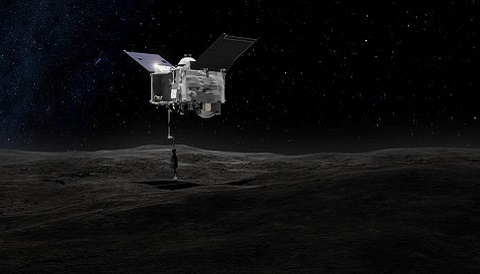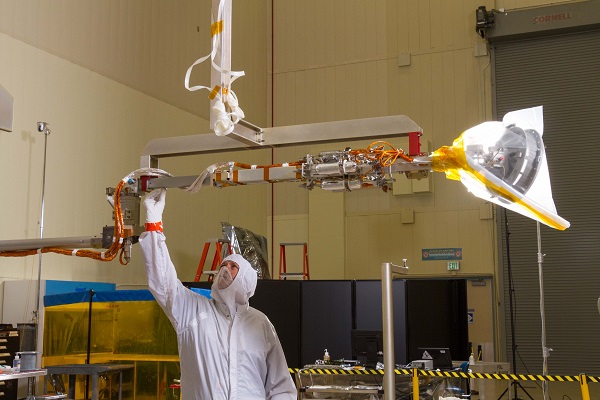The Osiris-REX spacecraft will sample one of four sites on the asteroid Bennu in July 2020.

NASA
And then there were four.
NASA mission planners have announced that they've narrowed down the potential landing sites on asteroid 101955 Bennu to four locations. The Osiris-REX spacecraft will touchdown at one of these sites next year and collect a sample.
The site selection comes after a careful survey of Bennu's jumbled surface. Approximately 0.3 mile (0.5 kilometer) in diameter, tiny Bennu presents a unique challenge for an asteroid to approach.
“We knew that Bennu would surprise us, so we came prepared for whatever we might find,” says Dante Laurette (University of Arizona Tucson). “As with any mission of exploration, dealing with the unknown requires flexibility, resources and ingenuity.”

NASA / University of Arizona
Osiris-REX (the Origins, Spectral Interpretation, Resource Identification, Security, Regolith Explorer) launched from Cape Canaveral atop an Atlas V rocket on September 8, 2016. Osiris-REX made a gravitational assist flyby of the Earth on September 22, 2017, before arriving at Bennu on December 3, 2018.
By now, NASA had hoped to have the site selection process down to two. But that was before Osiris-REX mapped the asteroid's rugged surface in an effort to find the optimal landing site. As always in planetary exploration, there's a tension been looking for a site that's safe versus scientifically interesting. The Osiris-REX team is looking for a site on Bennu that has fine grain material less than 1 inch (2.5 centimeters) in diameter. The team hopes to collect 60 grams of material for return to Earth — about the mass of an alkaline C battery. Even though it's a tiny amount, it would represent the largest sample return to Earth from another world since the Apollo program.
Osiris-REX is the third mission in NASA's New Frontiers program, after New Horizons and Juno. The next New Frontiers mission is the Dragonfly mission to Saturn's moon Titan, expected to launch in 2026.
Fortunately, the mission timeline allows an extra 300 days for the team to carefully assess each site. The four sites are named Kingfisher, Nightingale, Osprey, and Sandpiper, after birds native to Egypt. This is in line with the Egyptian theme for the mission: Osiris is the Egyptian god of the underworld, and Bennu is a god linked with creation and rebirth.
Each site has its pros and cons:
Nightingale is located the farthest north, in a small crater that's encompassed by a larger, 140-meter-wide crater. The sampling area shows the lowest albedo (reflectivity) and surface temperature of the four potential sites, suggesting the presence of dark, fine-grain material suitable for collection.
Kingfisher is located near the asteroid's equatorial region. The site is in a small, 8-meter crater that's surrounded by boulders, but the crater floor itself is clear of large rocks. The site also shows a strong spectral signature that indicates the presence of hydrated material.
Osprey is also located in Bennu's equatorial region, inside a crater that spans 20 meters. The surrounding area displays diverse rock types, so the site itself may also be diverse. Of the four sites, Osprey shows the strongest signs of carbon-rich material.
Sandpiper is the farthest south of the four sites, and is located inside a 63-meter-wide crater. There are hydrated minerals at the site, so it may have pristine, water-rich material.
Next Steps
Now, the Osiris-REX team will begin a detailed survey of the four sites. The first step is a series of mapping passes 1.3 kilometers over each site, surveying the terrain for features and obstacles that will affect the spacecraft's autonomous navigation system. The team will announce the two final sites — a primary and a backup — in December. The team will direct Osiris-REX to make ever-closer survey passes over each site in early 2020.
Sampling will occur using the Touch-and-Go Sample Acquisition Mechanism, known as TAGSAM. The system uses a sample collection head on the end of an 3.4-meter articulated arm. Once the arm contacts the surface, it will fire short nitrogen bursts to stir up material for sample collection. TAGSAM has enough nitrogen for three sampling attempts.

NASA
“Although Osiris-REX was designed to collect a sample from an asteroid with a 'beach-like' area, the extraordinary in-flight performance to date demonstrates that we will be able to meet the challenge that the rugged surface of Bennu presents,” says Rich Burns (NASA-GSFC). “That extraordinary performance encompasses not only the spacecraft and instruments, but also the team that continues to meet every challenge that Bennu throws at us.”
After sample collection, Osiris-REX will depart Bennu in March 2021. The sample return capsule with reenter over the Utah Test and Training Range on September 24, 2023.
It will be exciting to watch the action unfold as Osiris-REX approaches Bennu and makes history.
 1
1









Comments
Jim-Baughman
August 19, 2019 at 2:21 pm
I love this post!!!
Elegantly written, with excellent illustrations appropriately sized for my un-perfect eyesight.
This mission exemplifies NASA's dedication to creating systems to deal with any eventuality. It is a tribute to their traditional thoroughness that they are taking their time finding just the right spot for sampling.
You must be logged in to post a comment.
You must be logged in to post a comment.